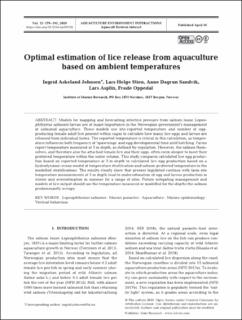| dc.description.abstract | Models for mapping and forecasting infective pressure from salmon louse Lepeophtheirus salmonis larvae are of major importance in the Norwegian government’s management of salmonid aquaculture. These models use site-reported temperature and number of egg-producing female adult lice present within cages to calculate how many lice eggs and larvae are released from individual farms. The reported temperature is critical in this calculation, as temperature influences both frequency of ‘spawnings’ and egg developmental time until hatching. Farms report temperature measured at 3 m depth, as defined by regulation. However, the salmon themselves, and therefore also the attached female lice and their eggs, often swim deeper to meet their preferred temperature within the water column. This study compares calculated lice egg production based on reported temperature at 3 m depth to calculated lice egg production based on a hydrodynamic ocean model of temperature stratification and salmon-preferred temperature in the modelled stratifications. The results clearly show that present legislated routines with farm site temperature measurements at 3 m depth lead to underestimation of egg and larvae production in winter and overestimation in summer for a range of sites. Future mitigating management and models of lice output should use the temperature measured or modelled for the depths the salmon predominantly occupy. | en_US |
